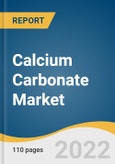The global calcium carbonate market size is expected to reach USD 68.4 billion by 2030. It is expected to expand at a CAGR of 5.4% from 2022 to 2030. Calcium carbonate is a compound that is commonly found in rocks, such as limestone and dolomite. The product is extracted by quarrying or mining and is further processed to form Precipitated Calcium Carbonate (PCC) or Ground Calcium Carbonate (GCC).
The product is extensively used in various applications including paper, paints and coatings, food, health-related products, and building and construction materials. The COVID-19 pandemic impacted both the production and consumption of calcium carbonate. However, the demand is high in the healthcare market and related industries, mainly in the paper industry due to rising concerns regarding personal hygiene, which is boosting the demand for tissue papers.
The global market is highly competitive owing to the presence of numerous established players in the industry that are integrated across the value chain. In January 2021, Audax Private Equity announced the completion of the sale of Gabriel Performance Products to Huntsman Corporation. The competitive scenario is intense for the market as major players have reported losses during the first half of 2020. For example, Mineral Technologies reported a loss of 14.44% and Imerys reported a loss of 15.3% in their revenue for Q2 2020.
This product will be delivered within 1-3 business days.
The product is extensively used in various applications including paper, paints and coatings, food, health-related products, and building and construction materials. The COVID-19 pandemic impacted both the production and consumption of calcium carbonate. However, the demand is high in the healthcare market and related industries, mainly in the paper industry due to rising concerns regarding personal hygiene, which is boosting the demand for tissue papers.
The global market is highly competitive owing to the presence of numerous established players in the industry that are integrated across the value chain. In January 2021, Audax Private Equity announced the completion of the sale of Gabriel Performance Products to Huntsman Corporation. The competitive scenario is intense for the market as major players have reported losses during the first half of 2020. For example, Mineral Technologies reported a loss of 14.44% and Imerys reported a loss of 15.3% in their revenue for Q2 2020.
Calcium Carbonate Market Report Highlights
- Asia Pacific accounted for the largest revenue share in 2021 and is expected to grow further on account of the rising focus on the development of the manufacturing sector in the region. Government initiatives for the development of the manufacturing sector by offering incentives and inviting FDIs are expected to benefit market growth. For example, in May 2020, Mineral Technologies signed an agreement with Satia Industries Ltd. to build a 42 kiloton per annum satellite PCC plant in Punjab, India. Satia Industries Ltd. is a renowned papermaker in India that will utilize Mineral Technologies’ PCC as a filler to enhance the opacity, bulk, and brightness of paper.
- The paper application segment was the largest application segment in 2021 and accounted for a revenue share of more than 40.0%. Growing concerns over sustainability and hygiene are driving the paper industry. For instance, initiatives undertaken to ban single-use plastic products have propelled the consumption of paper in packaging applications. In addition, the growth of this application segment is attributed to the high demand for paper from the packaging and healthcare industries.
- The plastics application segment is expected to register the fastest CAGR of 6.4% from 2022 to 2030, in terms of revenue, on account of its rising demand from the medical sector. It is 100% FDA-approved, which allows it to be used in food and medical applications as well. Plastics are widely used in the medical industry in various applications, such as disposable medical devices, surgical gloves, IV tubes, and other tools. These are one-time-use products and their demand has increased during the pandemic.
- The Middle East & Africa is anticipated to register a significant CAGR during the forecast period on account of rapid growth in the construction industry that is propelling cement production in the region.
This product will be delivered within 1-3 business days.
Table of Contents
Chapter 1. Methodology and Scope
Chapter 2. Executive Summary
Chapter 3. Market Variables, Trends, and Scope
Chapter 4. Calcium Carbonate Market: Application Estimates & Trend Analysis
Chapter 5. Calcium Carbonate Market: Regional Estimates & Trend Analysis
Chapter 6. Competitive Landscape
Chapter 7. Company Profiles
Companies Mentioned
- Agsco Corporation
- Blue Mountain Minerals
- Carmeuse Lime & Stone Company
- Gccp Resources
- Glc Minerals, LLC
- Greer Limestone Company
- Gulshan Polyols Ltd.
- Ilc Resources
- Imerys
- J.M. Huber Corporation
- Lafargeholcim
- Midwest Calcium Carbonates
- Mineral Technologies
- Mississippi Lime
- Mountain Materials, Inc.
- Nalc, LLC
- Omya
- Parchem Fine & Specialty Chemicals
- the National Lime & Stone Company
- United States Lime & Minerals Inc.
Methodology

LOADING...
Table Information
| Report Attribute | Details |
|---|---|
| No. of Pages | 110 |
| Published | April 2022 |
| Forecast Period | 2022 - 2030 |
| Estimated Market Value ( USD | $ 44.5 Billion |
| Forecasted Market Value ( USD | $ 68.4 Billion |
| Compound Annual Growth Rate | 5.4% |
| Regions Covered | Global |
| No. of Companies Mentioned | 20 |









